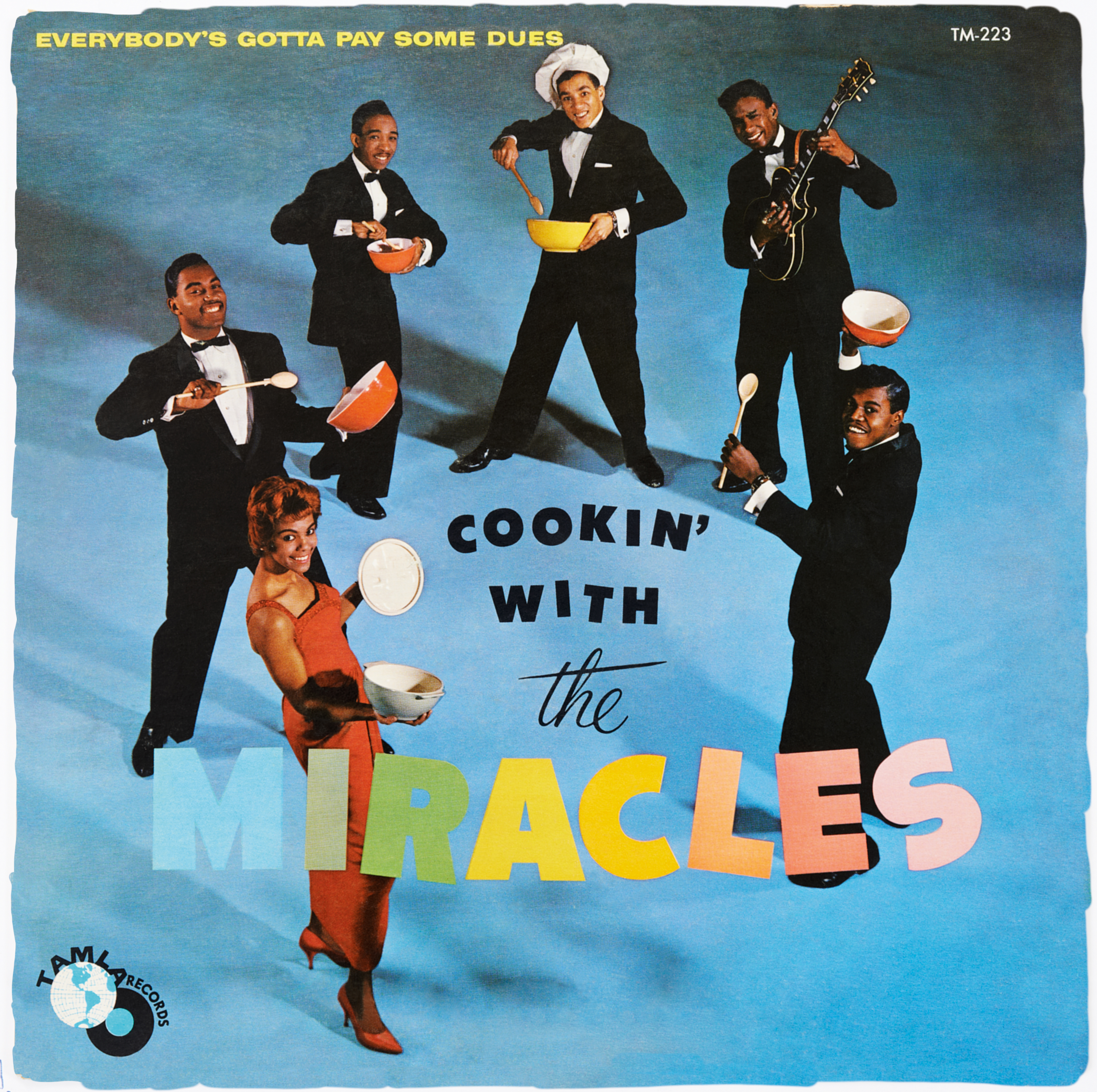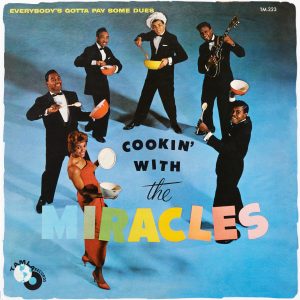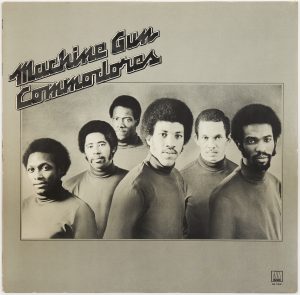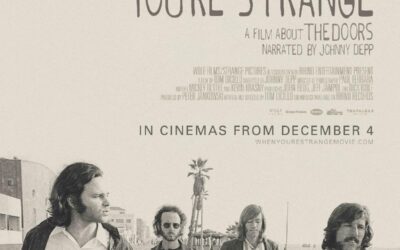By Harvey Kubernik c 2016
There have been many books about Motown and many Motown books.
With the September publication of Motown The Sound of Young America, by Adam White with Barney Ales, including a marvelous foreword by
Andrew Loog Oldham, we finally now have the ultimate visual history of the monumental record label.
Most notably, guided by a very telling retail point of view that finally captures the record company’s fiscal reality along with the strength of a dream legacy, now told and illustrated against a background of momentous social and cultural changes in America.
Sidebar
“The blast furnaces roar melting down the iron ore and blow black clouds of smoke out of the stacks. The fallout glistens from the particles of graphite suspended in the air below where I walk with a shovel over my shoulder along the railroad tracks on Zug Island. It’s the summer of 1964. Across the river from Detroit in Canada, the 50,000 watt CKLW-AM pumps Martha & The Vandellas’ ‘Dancing In The Streets’ through the transistor radio in my hip pocket. ‘All you need is music, sweet sweet music’ makes the walk down into the pit momentarily transform with the sonic medicinal of Motown.”
mick vranich, Detroit, 2009
End Sidebar
Motown: The Sound of Young America is the definitive print collection and history of the Detroit-based independent record company that became a style unto itself, a prolific and hugely successful production line of suave, sassy, and sophisticated music through the 1960s, 1970s, and 1980s.
Contained in the 400 page volume are extensive specially commissioned photography of treasures, over 1,000 of them in gorgeous color and black and white, gathered from the archives, this landmark exploration also displays the graphic and design iconography that underpinned Motown’s extraordinary creativity.
It is one compelling and revealing endeavor, reflecting the vision, hustle, and sonic achievements of Berry Gordy, Jr. on behalf of Stevie Wonder, Smokey Robinson & the Miracles, Diana Ross & the Supremes, Marvin Gaye, The Jackson 5, the Temptations, and many more.
It’s packed with fresh insights gleaned from scores of interviews with key players, this terrific and awe-inspiring book delves into the workings of the Motown machine and details how a dedicated team of backroom believers, white and black, turned a small family business into a popular music powerhouse as America underwent momentous social and cultural changes.
Adam White has written about music and the industry for more than forty years, and his work has appeared in Rolling Stone, Music Week, Radio & Records, The Times, NME, and elsewhere. He was editor-in-chief of Billboard, co-authored The Billboard Book of No. 1 R&B Hits and was Grammy-nominated for The Motown Story (1983) and Heaven Must Have Sent You: The Holland/Dozier/Holland Story (2005). White was vice-president of communications at Universal Music Group International from 2002 to 2012.
Adam White: “Barney Ales and his crew – Phil Jones, Irv Biegel, Gordon Prince, Al Klein, Mel DaKroob, Miller London and more – got the records played and the company paid. We know the music matters most of all, but without that team’s nitty-gritty of promotion, sales and distribution, Motown might never have soared.”
Barney Ales was Berry Gordy’s indispensable right-hand man and Motown’s ultimate insider, whose job was to get the records played and the company paid. He rose to become executive VP and general manager, but stayed in Detroit in 1972 when Gordy moved Motown to California. Ales became its president in Los Angeles during his return to the firm from 1975 to 1978.
Andrew Loog Oldham discovered, then managed and produced the Rolling Stones from 1963 to 1967. He worked as a producer for Motown’s Rare Earth label during the very early 1970s. He produced the Connecticut group Repairs and Detroit band the Sunday Funnies.
Andrew Loog Oldham: “Barney Ales – the jewel in the crown. His efforts on behalf of Mr. Gordy and the artists were the primary reason the sound of young America graduated all over the world.”
The earlier impact of Motown Records on Andrew informed his 1963-1967 recording studio produced efforts with Rolling Stones. Oldham and his group covered “Money (That’s What I Want),” as well as Motown/Jobete Music entries “Can I Get A Witness,” “Money (That’s What I Want),” “Hitch Hike” and “My Girl.”
“‘Can I Get A Witness’ is a great young version by the Stones,” Andrew reinforced to me in a 2004 email interview. “Mick (Jagger) was out of breath on this one as he’d run across Soho to UK’s Motown publisher’s Freddy Bienstock to get the lyrics. ‘Hitch Hike’ is a bit mindless and even though the track of ‘My Girl’ is a bit naff Mick nailed the vocal.
“But it’s the spirit that counts and Motown made you feel everything was possible. It’s rhythms were very often unusual for Top 20 fare and the
lyrics and delivery spoke to young moments.”
In his passionate introduction to Motown The Sound of Young America, Andrew Loog Oldham writes, “Long before a cartoon tongue came to be known worldwide as the essence of excess, Tamla Motown, as the label was called in the UK, was a Brand, a 360-degree, vertically integrated, celebration of sound, style, and success. Most importantly Motown embodied African-America’s unstoppable and growing self-confidence. The Motown imprimatur on an unknown artist or an unheard new record was a guarantee of quality no other record company could equal. For us beat boomers, ‘The Sound of Young America’ was as inspiring as the March on Washington was for Motown’s native speakers.
“Years before Apple became the world’s most successful company, Motown was the first ‘aspirational’ brand. The world’s love of Motown was uniquely omnisexual: boys and girls adored it in equal measure.
“Where chicks had clutched Elvis and Cliff to their noisy bosoms, guys preferred hard rockers such as Eddie Cochran, Gene Vincent and Little Richard. But Tamla-Motown provided a soundtrack on which we could all agree: dancing, driving, or dressing up, we dug it.
“Meanwhile, in a slightly shabby office located upstairs at ‘Hitsville U.S.A.’ in Detroit, a young white man directed the distribution and monetization of Motown’s vast recording and publishing catalog. Berry Gordy, Jr may have been the Diaghilev to multiple African-American Nijinskys, but it was Barney Ales who dealt with the white rack jobbers and one-stop operators who were perhaps only a half-step removed from the jukebox racketeers.
“Ales had the vision to take the business international at a time when the likes of Epstein and myself were fumbling our way in the New World. Berry realized he’d found a partner who could help make the white-dominated music industry dance to his tune. Ales remained vice president of sales at Motown until 1972 and, after a time running his own Prodigal Records, returned in 1975 to become president.
“There is no one more qualified than Adam White to take you behind the scenes, into the halls of Hitsville and onto the factory floor where Berry
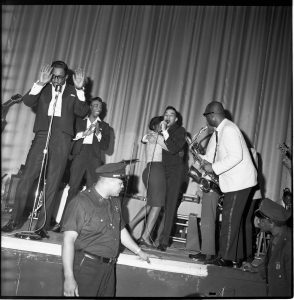
The Miracles light up the night during a show in the early 1960s.
Motown Records Archives. Courtesy of the EMI Archive Trust and Universal Music Group.
Gordy and Barney Ales staged a revolution. I feel blessed to have known music man Barney Ales. Now it’s your turn.”
Russ Regan has been in the record business for over 60 years. The memorable L.A. fixture has played a major role in the careers of the biggest names in the music business: Elton John, the Beach Boys, Neil Diamond, Barry White, Olivia Newton-John, and the Alan Parsons Project. He was a former President of UNI/MCA Records, (now Universal Music), and a Motown/Jobete Music executive.
Russ Regan: “Sonny Bono said to me that I should be a record promoter and I then met George Mattolla who got me a job at Buck Eye Records in L.A. in November 1960. It was a distributor. They were located on Pico Boulevard. A woman from Cleveland owned it and that’s why she named it Buck Eye. The recording artists and record label executives would come to Buck Eye. Barney Ales from Motown.
“I was recruited by Motown Records. Berry Gordy offered me a job but I didn’t want to move to Detroit. I’m a California guy.
“The first record I promoted was ‘Please Mr. Postman’ by the Marvelettes in 1961. I also worked with the Supremes, Smokey Robinson & the Miracles, and Marvin Gaye. AM R&B radio stations like KGFJ and KDAY in Los Angeles really got behind the Motown label’s sound.
“Believe it or not, Marvin Gaye had moments of greatness on stage or he could be lousy. And I’ll tell you why. He really didn’t like performing. It was a job to him. It can’t be a job for a performer. People don’t realize this. You can’t be up there thinking you are working. There used to be record hops at high schools. Groups played in the auditorium. We went to Fairfax High School. One time at Jefferson High school I took Marvin Gaye to Watts. He had never been out there before. The girls attacked him. He lost one shoe of his penny loafers.
“Barry Gordy, Jr. used to come to town. He taught me about hooks in songs. And that people buy records because they have to love them, not like them. And I was taught a lot about the record business by Berry Gory, Jr. I became a promotion man three years 1961-1964. I learned the value of a song and the hooks of a song. Every Motown hit has hooks in it. It starts with the opening. You can always smell the opening of a Motown record.”
Al Kooper: I’ve probably cut four Smokey [Robinson] tunes over my career. He’s special. One of my favorite things is when I called [Bob] Dylan one day and said, ‘Hey…What are you doing?’ ‘Eating a piece of toast and listening to Smokey Robinson…’ So, that makes a lot of sense.”
In 2001 I interviewed Berry Gordy, Jr. inside his Bel-Air home for HITS magazine, just after he published his autobiography, To Be Loved.
HK: Motown began with 45 records. Then the album format, eventually 8-track tapes, cassettes and now compact discs. Were you personally impacted by the growth of the LP market?
BG: Now very much. We were about producing songs that were great. And so a lot of the producers who would be coming to our Friday morning meetings, they would say when the song wasn’t that great. ‘Oh, that’s an album tune. That’s just going on the album.’
“I’d say, ‘No. No. There are no album tunes. Every tune has to stand on its own.’ We didn’t look at album tunes as such. We would pick tunes that were hits and that’s why they would go on albums. And pull out a hit here, a hit there, you know? So it didn’t impact us that there were albums and we had departments and all that stuff. But as far as recording, unless there was a concept album and things like that, we would say there are no album tunes. We’d say that all the time.
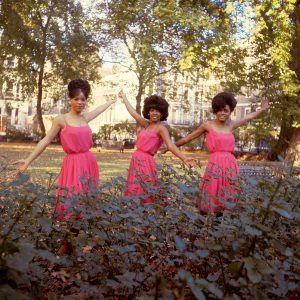
UNITED KINGDOM – JANUARY 01: Photo of SUPREMES and Diana ROSS and Florence BALLARD and Mary WILSON; Posed group portrait L-R Florence Ballard, Mary Wilson and Diana Ross (Photo by RB/Redferns)
HK: What was your first impression of Smokey Robinson?
BG: Well, Smokey Robinson, my first impression was he was great, a great poet, but he didn’t know how to really write songs, or put songs together. When he learned how to put stuff together and he really understood, Smokey was incredible. When I turned down his first 100 songs, he got more excited with every song. I said, ‘This guy has to be either crazy or one of the most special people I’ll ever meet.’ He was incredible. He turned out to be one of the most special people I ever met.
HK: And with an angelic voice
BG: Oh, yes. Pure. And then, he got it and understood it. So now Smokey has succeeded at the cycle of success. It takes a lot of character, because you are tempted along the way. The cycle of success is a vicious cycle. It takes you into places. People offer you things never offered before. To succeed and be successful is tough so it takes a lot of character. You got to keep your same values. So Smokey has done that. The Four Tops have done that. And most of the Motown artists have it drilled into them and they were all very tight.
HK: Marvin Gaye?
BG: The truest artist I’ve ever known. Whatever he was going through in his life he put on records. So if you want to know Marvin just listen to one of his records.
HK: Stevie Wonder?
BG: Innovative. The most innovative person that I’ve ever known. But also unique with his tones and his voice quality and all that. He was as close to genius, and I don’t like to use the word genius, you know. Marvin could have been a genius. I don’t like to throw it around, but Stevie is one of those kind of special, special, special people that had a sound, and he’s quick. He’s creative and he can make up something very quick.
HK: And he is involved in technological developments.
BG: That’s what I’m saying. Contraptions. He would take technology. He was the first in technology. He’s an innovator.
HK: Michael Jackson?
BG: Greatest entertainer in the world and one of the smartest people and businessmen in the world. He conducted his own career, basically. He knew what he wanted. And from nine years old he was a thinker. And I called him ‘Little Spongy,’ because he was like a sponge and he learned from everybody.
“He not only studied me, but he studied James Brown, Jackie Wilson, Marcel Marceau, Fred Astaire…Walt Disney. And he bought the Beatles’ catalog. Michael is nobody’s fool. Very bright. Very smart.
HK: The Holland, Dozier and Holland production and songwriting team?
BG: H-D-H was phenomenal. They came up with hit after hit. They started a thing. They had a lock on the Supremes and they took them, and did stuff on Marvin. H-D-H was absolutely brilliant. The three of them were different and they all complemented each other.
“Eddie (Holland) did mostly vocals, Brian (Holland), I thought was the most talented, creative person. He was my protégé for many years. I thought Lamont(Dozier) was also a good writer, and he was good on backgrounds and this and that and so forth. But Brian would do something like he would play and sing and create something and all he would give ‘em was, like, ‘sugar pie honey bunch,’ and pass it on. So they had their own assembly line. And they were tremendous.
HK: The producer and songwriter, Norman Whitfield?
BG: Norman to me was probably the most underrated of all the producers, because he was producing by himself. And he would deal with different sounds, different beats, change with the times and write his stuff, and also Barrett Strong would work with him as a writer on many of his things. Norman was innovative and he had fire. And he had a different kind of style.
“His beat was different and could go from ‘Cloud Nine,’ ‘Psychedelic Shack,’ “Papa Was A Rolling Stone,” to ‘Just My Imagination.’ He was sensitive
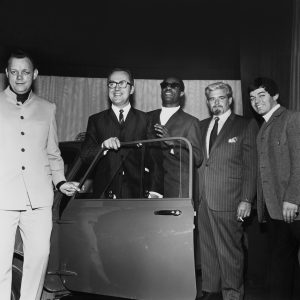
Stevie Wonder presents a “Motown Mini” to a British competition winner in London, 1969, alongside the company’s Phil Jones and Barney Ales and, at right, DJ Tony Blackburn.
Courtesy of Barney Ales
and I think he could do so many different types of things. Then he’d come right back with ‘War’ and then ‘Ain’t Too Proud To Beg.’
“He could take one chord, like on ‘Papa Was A Rolling Stone,’ and play the same chord and do all these different beautiful melodies and things that many people could not really imagine this guy doin’. And I would watch him and he did it all by himself as a producer. He would work with five guys in the Temps and he would change leads on each one. He would pick the right lead for the right song, ya know, and he’d utilize all five of those leads in a song that was just incredible.
“When I listen to them today, now that I have time to listen to ‘em, I’m saying, ‘Wow! This guy was probably the most underrated producer we had.’”
In November of 1974 for Melody Maker I interviewed in Hollywood the now departed Bobby Rogers, a member of the famed Miracles, since their inception in 1958, when he joined up with his sister Claudette, Ronnie White, Pete Moore, and William Smokey Robinson.
Bobby Rogers: “The Miracles have always to this point been a singles-orientated group. Smokey was writing for the group and everybody else. Smokey never really had the opportunity to do a concept thing. The best thing that ever happened to music has got to be the What’s Going On album by Marvin Gaye. Marvin was listening to everything that was around. Beatles, Stones, Pop, and Jazz.
“You know that Sgt. Pepper LP? It was always on Marvin’s turntable. Marvin took some time off and really looked at what was happening. Society has changed. A long time ago black people were smoking dope and if they got caught they would go to jail. Now, white people are doing it and they bring the penalty down. Also, we had some racial hassles years ago in the South, and it’s getting better now.”
“I really loved touring with the English groups, back in 1963 and 1964. We used to tour with the Rolling Stones and people like Georgie Fame. During the breaks from touring, a lot of the groups would ask questions about certain songs on our albums. I remember when we filmed The TAMI Show Mick Jagger asked me about what I’d thought of the album James Brown Live At The Apollo, which was his favorite LP.
“One time on a tour he mentioned that he’d like to record a Marvin Gaye song for the next Stones album. A month later, ‘Hitch Hike’ was being played all over Detroit radio.
“Man, those early tours were a trip. Endless hours of bus rides and all these skinny English dudes asking us about the Tamla Motown sound. I never realized how important or influential we were on groups like the Beatles and Stones. He said his name was George and he was in a group named the Beatles. We used to party with all the groups, and have become good friends. You know, music travels in sort of a cycle. The early days were beautiful. We dug all the people we played with. Back in 1965 my favorite song was ‘Get Off My Cloud.’”
Rogers, who shared the exact February 19, 1940 date of birth as William “Smokey” Robinson in the same Detroit hospital, co-wrote a number of tunes with Robinson: “The Way You Do the Things You Do” for the Temptations, “First I Look at the Purse” cut by the Contours and the Miracles’ “Going to a Go-Go.”
In February of 1976, I interviewed the late David Ruffin in Hollywood for a Melody Maker profile.
“The Temptations were individuals who happened to sing together. I never regretted any of the songs we did and even the choreography on stage has been widely copied. I liked the dancin’ part of that group. Then you couldn’t just stand there and sing. The audience was moving and you just reflected what was goin’ on. If anything, I’d like my association with the Temptations to be remembered as that we gave something. We helped young artists get in a position.”
Ruffin simultaneously remembered, even during the chart success of “My Girl,” only ten years earlier, he and the Temptations were subjected to unfair restaurant incidents during tours and many situations that at times were shocking.
“We went through a few mindbenders. Some cats had to buy us food ‘cos restaurants wouldn’t serve us, mostly in the south. Things are much better today but I can think of the times when I was driving independently of the group in my Cadillac and the police didn’t like black people with money or any fame, made me get out of town. They wouldn’t even let me stay overnight. I was visiting my mother once time. Parked the car outside and the cop said, ‘you can’t park it here.’ I knew why he didn’t allow me to stay with Mama. Yet the musicians and later on all kinds of kids went to our shows. We would rap and sing on the bus ride between concerts and it was a lot of fun.”
Ruffin praised the likes of Mick Jagger and Rod Stewart, delighting in telling me about coming out on stage in Detroit at Cobo Hall and singing the Temptation’s classic ‘I’m Losing You” with Stewart.
But there was one moment later when Ruffin broke character in our chat. He ran down his solo hit single “My Whole World Ended (The Moment You Left Me)” “A lot of people said it was a mental thing and that I could never make it without the group,” he mildly boasted at that time.
Soul music legend Bobby Womack knew Ruffin from when they were teenagers. In a 2009 dinner discussion I had with Bobby he acknowledged Ruffin’s seismic performance with the Temptations at The Trip nightclub in Hollywood in 1966 as well as Ruffin’s impact on his own musical journey.
“See, me and David Ruffin of the Temptations were very close. From years ago when we were singing Gospel as teenagers, and they had this big talent show in Detroit with the Staple Singers, the Womack Brothers. And David was singing with a group Ollie and the Nightingales out of Memphis. He was only 13. But he had so much charisma. When he walked on stage…30 years later we talked about it, ‘Man, you took that trophy from me.’
“I would follow Ruffin around. To make a long story short, he became the Temptations and the Temptations became David Ruffin. He would always treat me the same way but he’d add, ‘these guys don’t understand our relationship. They don’t know how long we’ve known each other.’ Then I became friends with all of them. He blew minds at the Trip, and he was a guy I said, ‘I’m gonna learn something if I can. What is it?’”
In 2003 I interviewed original Supremes’ member Mary Wilson. I asked her why the songs and recordings of Motown are so durable and still popular.
Mary Wilson: “That’s one of those questions like asking about love. But, I think all of the things we are recognizing now, the Motown label, The Funk Brothers, musicians, Berry Gordy, here we are 30, 35 years later and people are still re-recording those songs. Berry Gordy was an innovator, and he knew talent when he saw it. He only accepted the best. He allowed people to create on their own. He allowed the producers to really inspire each other. There’s no real answer to your question other than I know when I was recording those songs, it was the people, it was the music…Who knows. Any bass player out there listened to Motown records to learn how James Jamerson played. Any new female group coming up will definitely try and take something from The Supremes. It was like we were the model for music. The Motown sound was the model. And the music is universal.
“One thing I remember Berry said that had something to do with it. ‘This is the sound of young America. There is no time on it. I want to make this music where everyone in the word can listen to it and enjoy it. We’re singing from our guts. I want to make music that everyone around the world can enjoy.’ And that’s what he did. How, I don’t know…
I have to give credit to Berry for putting us with Holland, Dozier and Holland.”
Another marvelous re-discovery in the pages of Motown The Sound of Young America are the various photos of Motown acts snapped on network and syndicated television shows.
I had witnessed some of the 1960s Motown Records live road shows in Los Angeles and Hollywood and attended and danced on a handful of music TV shows when the Motown groups would perform: 9th Street West on Melrose Avenue, American Bandstand on Vine Street, and also watched live tapings of Shindig! on Prospect Avenue.
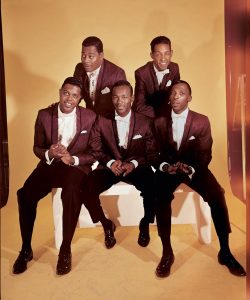
The Contours, from L to R: Jerry Green, Sylvester Potts, Council Gay, Huey Davis, Billy Gordon.
Courtesy of the Paul Nixon Collection
Musical history now underscores how vital television exposure was for the label’s recording artists. None were more essential as an appearance on The Ed Sullivan Show.
Andrew Solt: The relationship between Berry Gordy’s Motown label and The Ed Sullivan Show made music and television history. Soon after the Supremes’ debut on Sullivan (December 1964), it was clear that showcasing the latest Motown releases on CBS on Sunday nights (35 million viewers was average) until 1971 was a way to expose the record company’s newest hits and boost the show’s ratings. Sullivan introduced nearly all the Motown acts, including the Supremes, the Temptations, Stevie Wonder, the Four Tops, Smokey Robinson and the Miracles, Marvin Gaye, Gladys Knight and the Pips, and the Jackson 5.”
Mary Wilson: Ed Sullivan. For us, being on his show was so much more than record sales. It wasn’t about promoting us. It was about that we had grown up watching The Ed Sullivan Show. We had grown up watching shows where you didn’t see a lot of black people starring on those shows. For us, we were like every other family in America who spent hours watching Ed Sullivan. So for us, being on the show, was such a great honor. Because we were there to see the world changing. To see America changing. We were excited! We’re on The Ed Sullivan Show.
“We came from a time when a whole family of all different colors didn’t sit around ‘watching black people on television.’ The Dick Clark tours where before us there were segregated hotels. For us, that is what it was all about. We were part of that change. We were part of helping America to see black people, black women, being proud, beautiful and successful. It wasn’t just us. Many people before us. But they didn’t have the television to expose them to that wide range of people as we did at the time when we came. We were lucky. And we stood on a lot of shoulders. But we were there when the doors opened.”
Barney Ales: It was really a battle in those days to get black artists on network television in prime time. Sammy Davis Jr. and Nat Cole were about the only ones—anyone else, they just weren’t accepted. But when the Supremes broke through, we knew we had an opportunity. They looked so great, as well as sounding great. And Harvey Fuqua and Maxine Powell did a wonderful job, grooming the girls, getting them ready for prime time.
“The Ed Sullivan Show was the real breakthrough. Sunday nights, millions of people watching. Once Sullivan took to the Supremes, we knew we were on the right track. And album sales picked up like crazy whenever they were on, so we always made sure to tell the distributors they needed to check their inventory. After the Supremes, we got everyone on Sullivan’s show: Stevie, Gladys, the Temptations. We had a good relationship with the producer, Bob Precht. He liked Motown, and Esther, Berry’s sister, used to take the dressing room keys afterwards as souvenirs. They’re probably somewhere in the Motown Museum to this day.”
During Motown The Sound of Young America we are also reminded of the Funk Brothers, the musicians on the Motown recording session dates.
The core foundation Funk Brothers were: Joe Hunter, Johnny Griffith, and Earl Van Dyke on keyboards, Robert White, Joe Messina, and Eddie Willis on guitar, James Jamerson and Bob Babbitt on bass, Jack Ashford on percussion and vibraphone, Eddie “Bongo” Brown on congas and Benny Benjamin, Richard “Pistol” Allen, and Uriel Jones on drums.
Paul Riser, a Motown producer, who currently works with Lauryn Hill and Stevie Wonder once said, “As individuals they were great musicians, as a unit they were the best.”
Uriel Jones: “We made money recording, but we had our fun in the clubs. Back then some of the guys were pretty wild, and we drank up all our money. Sometimes we even owed money! At the time we were all jazz musicians. When we listened to the radio we listened to the jazz stations. We didn’t even know the impact these Motown songs were having. Suddenly it hit us that the radio was full of our tunes!
I asked about the “Ain’t Too Proud To Beg” tracking date Norman Whitfield produced with the Temptations.
“The intro was the last thing added to ‘Ain’t Too Proud To Beg’ with producer Norman Whitfield. We had cut the tune and I was messin’ around with the drums.
“On “Ain’t No Mountain High Enough,’ Marvin liked to use two drummers. He didn’t like one drummer bashing. He’d rather have two drummers giving the power and still laying back. Get that smoothness. Marvin used to love singing ballads. Lovely voice.”
Philadelphia, P.A.-birthed Jack Ashford, percussion and vibraphone, came to Motown at the request of Marvin Gaye in 1963. His tambourine was frequently heard much higher than was the norm in the recording mixes of the day. His work can be checked out on propulsive grooves on such classics as “War,” “What’s Going On” “Ooh Baby Baby, ” and “Where Did Our Love Go.”
Jack Ashford: We knew it was Marvin’s first time being a producer with What’s Going On. So that was nice. We knew he was talented and I didn’t know it extended to the area of writing, producing and playing. ‘Cause he played on the date. It was a different kind of session because he approached it different. He didn’t approach it as a producer. He approached it from a rehearsal and ‘let’s try this and see if it works.’ That type of a thing but with a concept in mind. It was new to him to. Something was different about it and I knew the very night we laid the tracks that something very unusual in that session. Everybody in the session felt it.
“With the tambourine on the sessions, I didn’t know the lyrics, or the melody. There was none. So like with Norman Whitfield, he was a frustrated tambourine player, anyhow. He gave me a little more leverage to be more creative spontaneously. Maybe a little more than some of the other producers because he depended on a lot of rhythm, as you can tell from his music. I had complete freedom to do what I wanted to do. But I played off my comrades and listened to what they did and the reason I did some of the things on ‘War,’ was because of something that was happening in the rhythm section. I had no idea it would have such an impact.
“My process…Well, number one and this is the one that I’ve used ever since I first started doing these things. I personally don’t think about what I’m getting ready to play. I really don’t. On sessions the first thing I would listen to is what James Jamerson was doing and what the drummers were doing. Because it was important that I locked into them and what Eddie ‘Bongo’ Brown was doing. It was important not to get in the way because I could do what I wanted to do. There’s plenty of room to move around rhythmically with a tambourine.”
The guitarist Eddie Willis hails from Mississippi. He was a part of many of the early Motown hits. His imaginative rhythm playing and flourished fills were a vital component of the “funk” in the Funk Brothers sound. His distinctive sound can be heard on “I Was Made To Love Her” and “The Way You Do The Things You Do.”
Eddie Willis: Levi Stubbs is a beautiful, beautiful person. I worked with him for 15 years on the road,” he volunteers. “If you need anything, ask Levi.
“On the ‘I Was Made To Love Her’ session, that’s me on the lead guitar, and it was a thrill. I knew at the time within a couple of weeks I would hear it on the radio. It jumped out of the AM car radio. I could not wait for that song to come out.”
Joe Messina: Paul Riser was my favorite arranger at the label. His arrangements were very interesting, and at the end, our charts were like little scores. He was very detail-oriented. He could write whatever he said, whereas in the earlier days they would hum the stuff to you and you would have to remember what was hummed to you.
“In jazz, I got to solo all the time. With Motown it was a little restricted, telling you what to do. I played mainly Telecaster. I converted a Telecaster body with a Jazzmaster neck. Because it was smoother. One of a kind.
“My favorite vocalist was Marvin Gaye. We never associated. We did our tracks and then he’d overdub. Marvin was a drummer and it made it a little
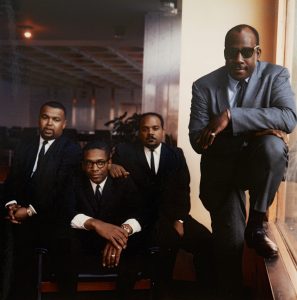
Bandleader Earl Van Dyke with the in-house Motown musicians who played on the Tamla-Motown UK package tour, pictured in London in 1965. From L to R: guitarist Rover White, percussionist Jack Ashford and drummer Bob Cousar, with Van Dyke.
Private collection
bit different. Levi [Stubbs] was my guy as well. H-D-H would come in with a chord sheet and say ‘Run this down.’ And we put our little things in there and they would keep it. That was their arrangement. We didn’t know we were donating like that (laughs).”
Berry Gordy Jr: We had a big story in [my book To Be Loved] about me and (bassist) James Jamerson when I threatened him and gave him an ultimatum and I was praying he would…I could have put him out. I wanted control of all the guys ‘cause I was the boss and I wanted to make sure they knew that, because otherwise I couldn’t have any order. And Jamerson, I mean, he came very close to me having a confrontation, but neither of us…he loved what he was doin’ and I loved him being there. But I still wanted him to have freedom in the restriction and he took it and was great.”
Earlier this decade, Detroit native musician and producer Don Was emailed me his reflections about Motown.
Don Was: It’s really important to bear in mind that The Funk Brothers were primarily JAZZ musicians reinterpreting R&B…that makes them way different from the Hodges Brothers or Booker T and Cropper or the guys in Muscle Shoals.
“They were sophisticated cats who brought a deep understanding of harmony and lyricism to these pop songs…They were used to wailing on, say, Duke Ellington’s songbook – which was way more complex than the early Motown music. One of the beautiful things about The Funks is that they never condescended to the audience or the material…..they used their musical knowledge to mine the emotional gold buried in the songwriting and lifted up every track that they played on.
“Remember, also that these guys were LOCAL Detroit jazz musicians – the basic geography of the situation meant that they were a little bit cut- off from the mainstream cultural centers of New York and LA….The insular, provincial nature of the scene resulted in a quirky reinterpretation / misinterpretation of then-current national R&B trends…oftentimes, reinvention outshines the original source from which it draws inspiration. A good case in point is the otherworldly bass playing of James Jamerson.
“If Berry Gordy had simply imported guys like Richard Davis or Milt Hinton or whomever was in fashion for New York sessions, these records might have ended up sounding like everything else out there at the time. Instead he entrusted the sessions to an unknown bass player who had invented a whole new way to approach the instrument. Somehow, Jamerson managed to play these melodic figures on the upbeats while still implying a relentless downbeat-based groove….He was like a guitar player, Latin percussionist, funky bass drum AND bass player all rolled-up in one! He’s such a charismatic musician!
“In fact, every one of the Funk brothers had really strong, unique musical identities. You couldn’t have made those records with different cats…And God knows that everybody tried!
“In the seventies, I was in a band with Pistol Allen….He wasn’t a big guy….Played really light….But he could swing like crazy and he had an enormous musical personality that belied his small physical stature…You could tell that he was the guy who drummed on those records even when you were playing songs that had nothing to do with Motown!
“One cat who I think has not been given his due as a Funk Brother is Dennis Coffey…..Maybe that’s because he came along later like Bob Babbitt. His first session was ‘Cloud Nine’- Dennis introduced the wah-wah pedal into the Motown vocabulary. I used go hear him play in a trio with a wonderful organist named Lyman Woodard….He could play all the Wes Montgomery and Kenny Burrell stuff but he’d add all these funky rhythmic figures….It was a previously unheard style of guitar playing – very original. He still gigs in Detroit…..You could take me into a club blindfolded and, even today, I could identify him as the guitar player in ten seconds. Gordy and his minions had a keen talent for putting these characters and weaving them into the Motown fabric.”
Mary Wilson has seen the inclusion of her Supremes’ songs and many Motown master recordings for decades utilized in TV and film soundtracks. What does she think about the usage of songs licensed from the original studio sessions and countless cover versions?
“Then, we didn’t think in those times the songs would be in TV or film. Like on China Beach they use ‘Reflections.’ Later, seeing that these songs were such great hits, and the years showed that they were really fantastic, other people recording them, you began to realize that what you know all along everybody else knew as well. We knew it at the beginning that they were great recording them. But when everyone else got it, what we knew was true. That’s the great part about it.”
(Harvey Kubernik has been a music journalist for over 44 years and is the author of 8 books. During 2014, Harvey’s Kubernik’s Turn Up the Radio! Rock, Pop, and Roll in Los Angeles 1956–1972 was published by Santa Monica Press.
In September 2014, Palazzo Editions packaged Leonard Cohen: Everybody Knows, a coffee—table—size volume written by Kubernik, currently published in six foreign languages. BackBeat/Hal Leonard Books in the United States.
Harvey and Kenneth Kubernik wrote the text for photographer Guy Webster’s award-winning first book for Insight Editions published in November 2014. Big Shots: Rock Legends & Hollywood Icons: Through the Lens of Guy Webster. Introduction by Brian Wilson.
In March, 2014, Kubernik’s It Was 50 Years Ago Today The Beatles Invade America and Hollywood was published by Otherworld Cottage Industries.
In November of 2015, Back/Beat/Hal Leonard published Harvey’s book on Neil Young, Heart of Gold).
During 2017, Sterling will publish Harvey Kubernik’s 1967 Complete Rock Music History on the Summer of Love).

